The Role of REDD+ in Incentivizing Forest Protection in Developing Countries
Introduction
Deforestation and biodiversity loss present critical global challenges, particularly in developing countries where forest ecosystems are integral to both environmental stability and local livelihoods. One of the most strategic frameworks designed to combat these issues is REDD+ (Reducing Emissions from Deforestation and Forest Degradation). By providing financial incentives to preserve forests, REDD+ aims to mitigate climate change while enhancing biodiversity. Understanding the implications of REDD+ is essential for addressing the larger context of deforestation and biodiversity loss, making it a focal point for researchers, policymakers, and environmental advocates alike.
Key Concepts of REDD+
REDD+ operates under several core principles aimed at incentivizing forest protection and sustainable management. Here are the major concepts:
- Carbon Credits: REDD+ allows countries to earn carbon credits through reduced emissions from deforestation.
- Financial Incentives: Developing nations receive funding to implement forest preservation strategies.
- Community Engagement: Involving local communities is key to successful REDD+ implementation, as they rely directly on forest resources.
- Monitoring and Reporting: Countries are required to monitor forest cover and report progress to ensure transparency and accountability.
Applications and Real-World Uses
The role of REDD+ in incentivizing forest protection has led to various practical applications worldwide. Some key examples include:
- Afforestation Projects: Countries like Brazil and Indonesia have initiated projects to restore degraded lands and enhance forest cover.
- Community-Based Initiatives: Programs in Central Africa engage indigenous populations in forest management, benefiting both the environment and local economies.
- Private Sector Engagement: Companies in the timber and agriculture sectors are adopting sustainable practices to align with REDD+ initiatives.
Current Challenges
Despite the promising framework of REDD+, several challenges hinder its effectiveness in combating deforestation and biodiversity loss:
- Issues with establishing clear land rights, which can lead to conflicts and reduced local participation.
- Insufficient funding and technical support for many developing countries to implement REDD+ effectively.
- Lack of comprehensive monitoring systems, making it difficult to assess the effectiveness of REDD+ efforts.
- Concerns over the permanence of carbon storage and the potential for “leakage,” where deforestation is simply displaced to other areas.
Future Research and Innovations
Future research in the area of REDD+ is focused on enhancing its efficiency and effectiveness in incentivizing forest protection. Innovations on the horizon include:
- Blockchain Technology: Utilizing blockchain for transparent transactions in carbon credit trading.
- Satellite Monitoring: Advances in satellite imagery that improve land-use monitoring and compliance checking.
- Regenerative Practices: Promoting agroforestry as a method to restore ecosystems while supporting agricultural production.
Conclusion
The role of REDD+ in incentivizing forest protection in developing countries stands as a vital strategy in the fight against deforestation and biodiversity loss. By aligning environmental goals with socio-economic benefits, REDD+ offers a framework that encourages sustainable practices. Continued research, innovation, and community involvement are crucial in overcoming existing challenges and maximizing the potential of REDD+. For more insights on related topics, read about the impacts of deforestation and explore biodiversity conservation strategies.



